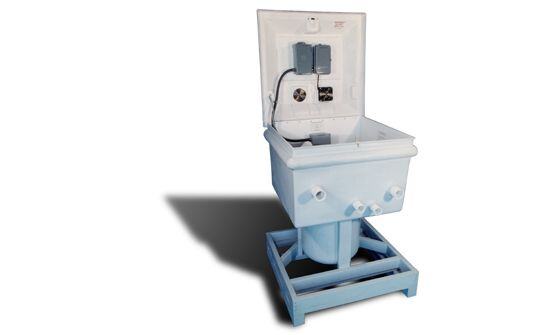
Vault-Pak™ Sand Filtration
The AF Series Vault-Pak™ is a cost-effective pre-engineered equipment vault, with an integral sand filter, that is designed for small to medium water features. Efficient layout and top access make it easy to maintain and service.
Product Specification
Standard Features:
• Heavy-duty FRP enclosure with 2” floor drain.
• Structurally engineered and certified for in-ground installation.
• 18” sand filter with multi-port valve for fountains up to 7,500 gallons (sand not included).
• Thermally protected pump.
• All necessary isolation and check valves.
• Pressure gauge.
• Power distribution panel and time clock.
• 110 CFM forced air ventilation fan.
• Lockable lid with lock-open arm, stainless steel lock hasp, and stainless steel hinge.
• Wall mounted maintenance procedures for all equipment.
• Stainless steel anchors and tie-down cables.
Optional Features:
• To add one 120 volt GFCI protected lighting circuit (rated at 1,800 watts) with one time clock, add suffix –L1 to catalog number.
• To add two 120 volt GFCI protected lighting circuits (rated at 1,800 watts each) with one time clock, add suffix –L2 to catalog number.
Note: Add 20 amps for each lighting circuit added to Required Amperage listed in chart, below.
Technical Notes
- Determine the total flow requirement by combining the total flow rate (GPM) required by all nozzles, then add 20 GPM for the filter, plus a 10% safety factor.
- Determine the total pump pressure requirement by taking the single highest nozzle head pressure requirement and adding a system friction loss allowance. An allowance of 25 feet of head pressure is adequate for simple piping systems with piping runs no longer than 75 feet. If the fountain system contains pools of different elevations, long piping runs, or more than a few nozzles, it is recommended that the pump pressure requirement be fully calculated.
- Locate the point on the performance chart where the total flow determined in Step 1 and the total head pressure requirement determined in Step 2, intersect. Any pump performance curve that passes above this point can be used. If this point is on or very near a curve, it is recommended that the next higher curve be used.
